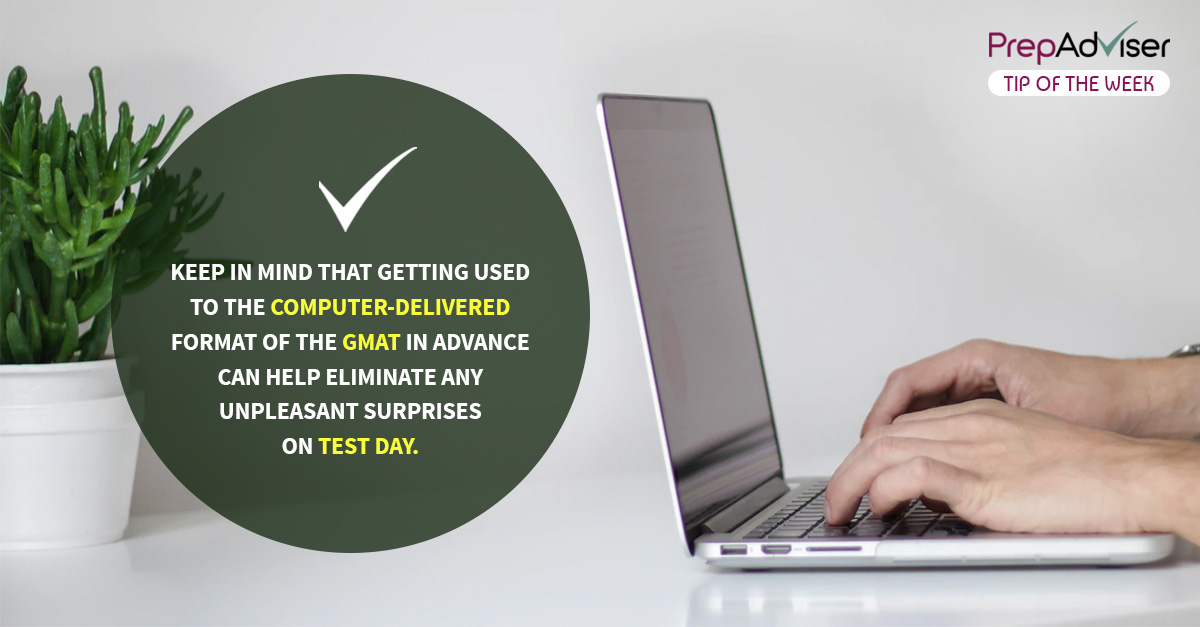There are a multitude of strategies to choose from. You can study the old-fashioned way on paper, use online materials and mobile applications, enroll in group courses, hire a tutor, or of course – warm up with practice computer-adaptive tests (CATs). To choose your optimal study strategy, you first need to understand the nature and format of the GMAT.
What does computer-adaptive testing mean?
Since the GMAT is delivered on a computer and there is no pen-and-paper version, there are a few important details all test takers should be familiar with early on, well before their test day. To begin with, the GMAT is computer-adaptive. This means that based on each answer you give, the testing software is able to adapt the difficulty level of the following question.
Check out: GMAT Note Taking Tips (Video)
For instance, if you answer your first question correctly, the software will generate a slightly more difficult second question and vice versa – if your first answer choice is wrong, the software will downgrade the difficulty level of the second question. Eventually, about a third of the way through the section, it zeroes in on your overall skill level and tailors all the remaining questions to your performance up to that moment. This mechanism makes the GMAT “much more efficient than a traditional, fixed-question test in which all examinees answer the same set of questions,” explains GMAC, the organization that administers the exam.
According to some test takers who have managed to achieve a top score, the computer-adaptive nature of the test should not worry you too much because you will not be directly aware of it throughout the exam. Of course, it is useful to prepare with it in mind, but when the time comes to sit the test, it is best not to focus too much on this aspect of the exam.
Check out: What is the GMAT: scoring, format, price and more
Key points to remember about the format
In order to become comfortable with the fact that the GMAT is delivered on a computer, there are several essential differentiators to keep in mind. Firstly, GMAT test takers cannot go back and change their answers to previous questions, nor can they skip questions – one of the major differences between a computer-delivered test and an exam administered on paper. Secondly, this also means that underlining or highlighting parts of the text is not possible. Nevertheless, you will be provided with a notepad and a marker so you can do all your note-taking and scratch-work by hand.

In addition, remember that although bringing a calculator into the test center is not allowed, GMAT takers can use the on-screen calculator, which is available only for the Integrated Reasoning section of the exam. Regardless of your choice of online or offline GMAT prep, getting used to these computer-specific factors in advance can help eliminate any unpleasant surprises on test day.
Online practice vs. pen-and-paper preparation
So, there are quite a few factors to consider when taking a computer-delivered test such as the GMAT, and there are also several strategies to explore for your exam preparation. As most experts will tell you, it is very important to complete mock exams on a computer during your practice sessions. Through them, you will be able to replicate the overall exam experience and the difficulty of the questions as closely as possible. By doing computer-adaptive practice tests, prospective GMAT takers are able to see if their time management and pace are good enough while also getting used to the overall structure of the exam.
Check out: GMAT vs GRE: Does the GMAT Give MBA Applicants an Edge?
When it comes to practicing with CATs, it is advisable to use the official starter kit provided by GMAC. Their version is guaranteed to use questions that have actually been asked in past exams as well as the same scoring algorithm as the real GMAT. Although many companies which offer tutoring and paid preparation resources also provide computer-adaptive mock tests, the only way to be sure of the authenticity and quality of the material is by opting for the known source.
While preparing for the computer-delivered nature of the exam is a crucial step of the study process, some experts also emphasize the value of pen-and-paper preparation. As a test taker, you will be familiar with most of the tasks and questions on the GMAT, such as algebra or analytical writing. However, as the last time you studied any of these subjects was probably all the way back in high school, you may need to brush up on at least some of them. This is usually accomplished much more efficiently when practicing on paper and spending enough time solving different types of questions and tasks. As advised by admissions consulting company MBA Applicant:
Only after you’ve internalized the GMAT curriculum by doing hundreds of practice problems should you download the official software from MBA.com and take the practice tests.
Ultimately, using a combination of study resources and opting for online and offline test prep that matches your learning style could turn out to be the winning strategy for you.
Check out: GMAT Tutorials: GMAT Quant – Geometry (Video)



